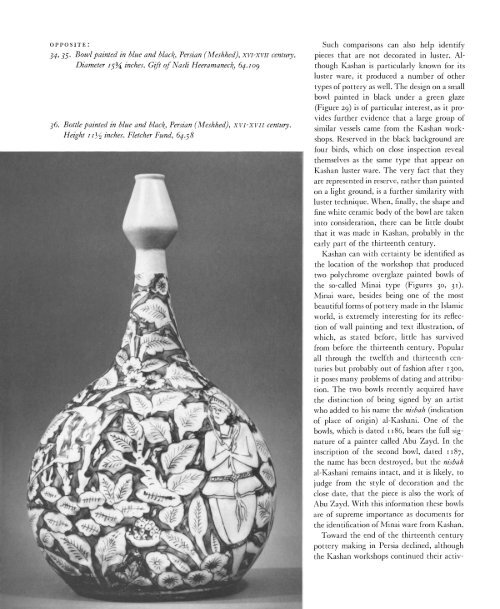Islamic Art: The Metropolitan Museum of Art Bulletin, v. 23, no. 6 ...
Islamic Art: The Metropolitan Museum of Art Bulletin, v. 23, no. 6 ...
Islamic Art: The Metropolitan Museum of Art Bulletin, v. 23, no. 6 ...
You also want an ePaper? Increase the reach of your titles
YUMPU automatically turns print PDFs into web optimized ePapers that Google loves.
OPPOSITE:<br />
34, 35. Bowl painted in blue and black, Persian (Aleshhed), XVI-XVI century.<br />
Diameter 155 inches. Gift <strong>of</strong> Nasli Heeramaneclk, 64.10o<br />
36. Bottle painted in blue and blacl, Persian (Meshhed), xvi-xVII century.<br />
Height I 1 inches. Fletcher Fund, 64.58<br />
Such comparisons can also help identify<br />
pieces that are <strong>no</strong>t decorated in luster. Although<br />
Kashan is particularly k<strong>no</strong>wn for its<br />
luster ware, it produced a number <strong>of</strong> other<br />
types <strong>of</strong> pottery as well. <strong>The</strong> design on a small<br />
bowl painted in black under a green glaze<br />
(Figure 29) is <strong>of</strong> particular interest, as it provides<br />
further evidence that a large group <strong>of</strong><br />
similar vessels came from the Kashan workshops.<br />
Reserved in the black background are<br />
four birds, which on close inspection reveal<br />
themselves as the same type that appear on<br />
Kashan luster ware. <strong>The</strong> very fact that they<br />
are represented in reserve, rather than painted<br />
on a light ground, is a further similarity with<br />
luster technique. When, finally, the shape and<br />
fine white ceramic body <strong>of</strong> the bowl are taken<br />
into consideration, there can be little doubt<br />
that it was made in Kashan, probably in the<br />
early part <strong>of</strong> the thirteenth century.<br />
Kashan can with certainty be identified as<br />
the location <strong>of</strong> the workshop that produced<br />
two polychrome overglaze painted bowls <strong>of</strong><br />
the so-called Minai type (Figures 30, 3i).<br />
Minai ware, besides being one <strong>of</strong> the most<br />
beautiful forms <strong>of</strong> pottery made in the <strong>Islamic</strong><br />
world, is extremely interesting for its reflection<br />
<strong>of</strong> wall painting and text illustration, <strong>of</strong><br />
which, as stated before, little has survived<br />
from before the thirteenth century. Popular<br />
all through the twelfth and thirteenth centuries<br />
but probably out <strong>of</strong> fashion after 1300,<br />
it poses many problems <strong>of</strong> dating and attribution.<br />
<strong>The</strong> two bowls recently acquired have<br />
the distinction <strong>of</strong> being signed by an artist<br />
who added to his name the nisbah (indication<br />
<strong>of</strong> place <strong>of</strong> origin) al-Kashani. One <strong>of</strong> the<br />
bowls, which is dated i86, bears the full signature<br />
<strong>of</strong> a painter called Abu Zayd. In the<br />
inscription <strong>of</strong> the second bowl, dated 1187,<br />
the name has been destroyed, but the nisbah<br />
al-Kashani remains intact, and it is likely, to<br />
judge from the style <strong>of</strong> decoration and the<br />
close date, that the piece is also the work <strong>of</strong><br />
Abu Zayd. With this information these bowls<br />
are <strong>of</strong> supreme importance as documents for<br />
the identification <strong>of</strong> Minai ware from Kashan.<br />
Toward the end <strong>of</strong> the thirteenth century<br />
pottery making in Persia declined, although<br />
the Kashan workshops continued their activ-

















